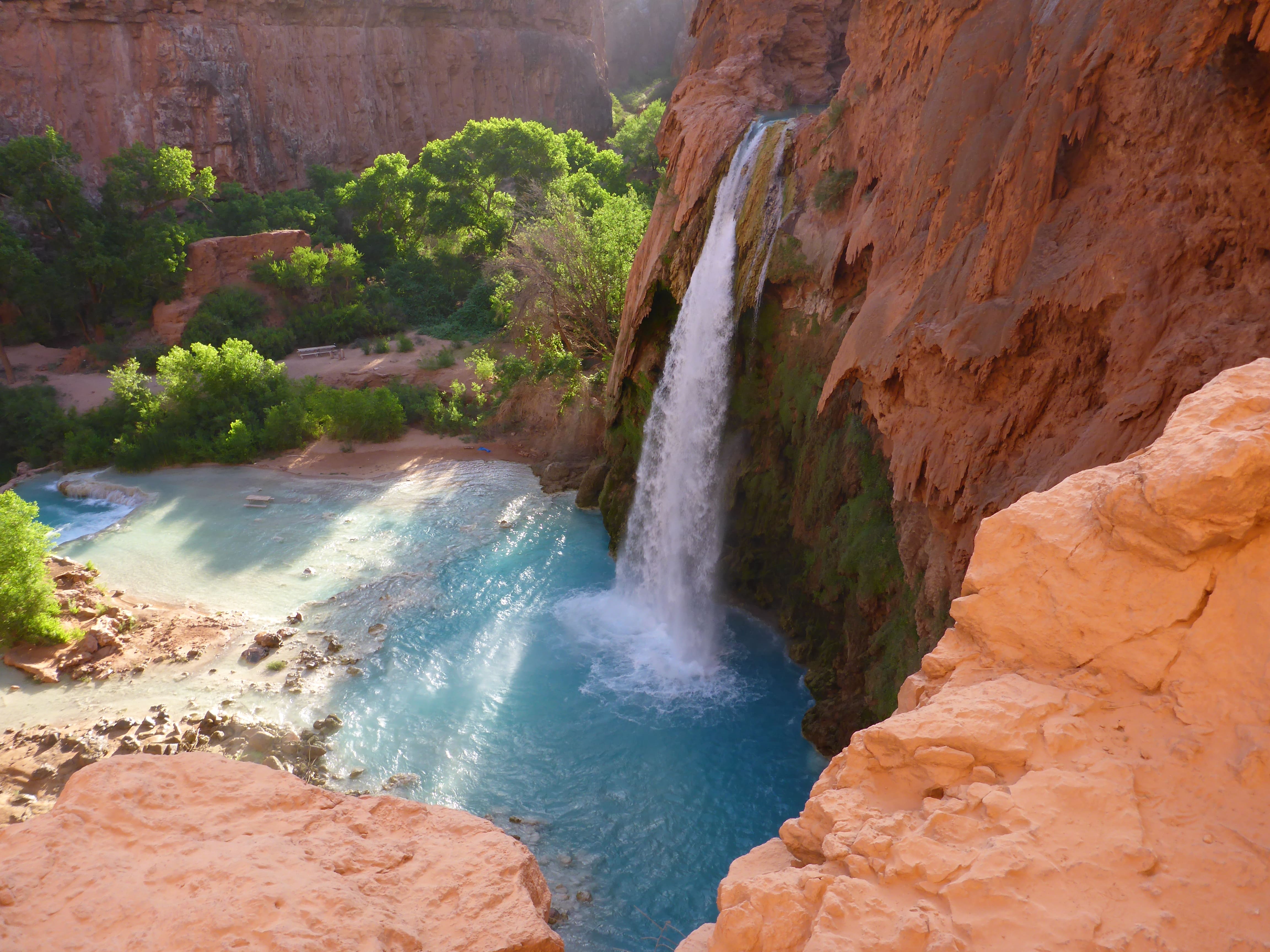Picture this: a waterfall roars just ahead, dropping a hundred feet to a pool of bright blue water. The rocks behind the falls form the same shape as the flowing water—as if the red-orange rocks had been flowing down, too, but had suddenly frozen in time, leaving a dramatic wall of copper-colored icicles. Lush green vines grow from the jagged rocks, hanging above the water’s edge. The water flows from the first pool over a series of uneven rock terraces, moving from pool to pool and on down the creek, the teal color in each pool just as vibrant as the last.

This scene is Havasu Falls. Though the characteristic blue-green color of Havasu Creek is reminiscent of the tropics, Havasu Falls is located in the desert Southwest, not far from the Grand Canyon in northern Arizona. The spring-fed Havasu Creek is the second-largest tributary of the Colorado River; you can spot the point where Havasu and the Colorado meet by a dramatic confluence of blue and brown at mile 157 of the Colorado. Havasu Canyon, where the creek flows, is even older than the Grand Canyon itself.
The blue of the Havasu has long drawn humans to live, work, and play in the waters and on its banks. The indigenous people of this region call themselves the Havasupai—in the local language, “ha” means water, “vasu” means blue-green, and “pai” means people. The Havasupai used the creek for irrigation during spring and summer, migrating upslope at other times of year. By 1919, the Havasupai were restricted to a reservation. Today, tourists to the Grand Canyon region seek out the creek and its waterfalls to swim in the blue waters and enjoy the scenery.
The unique features of Havasu Creek and its watershed have also been a draw for scientists. When hydrology graduate student Emily Edwards started reading about the Grand Canyon watershed for a seminar, the unusual color of Havasu Creek stood out. Emily had one question: why exactly is this desert creek so blue and bright?
She found the answer—the chemistry of the rocks and water hold the key. Because the Havasu is spring-fed, the water comes into the creek from underground, where it picks up minerals like magnesium and calcium from the rocks, resulting in high levels of dissolved magnesium and calcium in the waters of Havasu Creek. In addition, Emily says, as water flows into the soil and through the ground, it meets air with very high levels of carbon dioxide--100 times more than in the air we breathe. The carbon dioxide dissolves in the groundwater, forming a compound called bicarbonate. When the bicarbonate-rich groundwater meets the atmosphere in the desert springs that feed Havasu Creek, another chemical reaction occurs, and calcium carbonate—the same stuff that makes up chalk, snail shells, and eggshells—precipitates out of the water. Together, the dissolved magnesium and calcium and the suspended calcium carbonate reflect sunlight to create the turquoise color. The riverbed is made up of reflective limestone, which makes the color appear even brighter.
And in seeking out the reason for the blue of the Havasu, Emily learned that there was a lot more to the Havasu watershed than its color. The calcium carbonate formed when groundwater meets a spring doesn’t just reflect light—it gets deposited in the creek bed, forming rock formations called tufa and travertine, which shape the flow of the creek. Tufa is formed in cool, calm water, and can be quite soft, like a white mud. As a result, tufa can be reshaped or even washed away by large flows, creating an ever-changing stream channel. Travertine is very similar, but it is formed in areas of geothermal activity, where the water is warmer, and it is harder than tufa. Travertine makes up the attractive terrace formations at the base of Havasu Falls and throughout the creek.
Havasu Creek looks tranquil in most photographs, but like many southwestern landscapes, it experiences high intensity precipitation and flooding during winter rains and summer monsoons. In the late 1800s and early 1900s, floods occurred in the winter and summer months, with a few large winter floods and more frequent, smaller summer floods. Over the last century, however, flooding has occurred mostly as frequent summer events, since winters have gotten drier. In future years, climate change may drive increased precipitation intensity and more floods. Floods pose a risk to tourists and the Havasupai people, who are no longer able to migrate upslope as they once did.
The geology and hydrochemistry of Havasu Creek make it unique—but its story echoes the contrasting themes of so many beautiful places in the spectacular desert southwest: preservation and profit, tranquility and danger, and how forces of change shape an ancient landscape.
